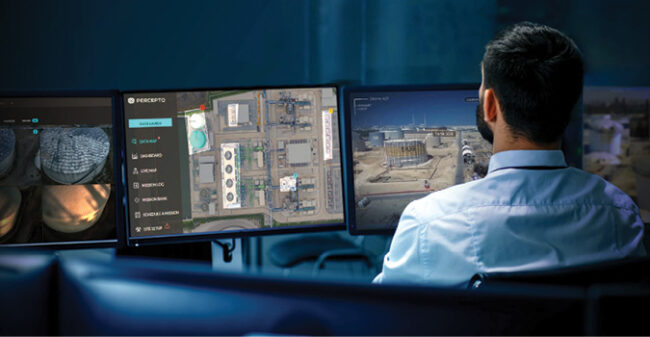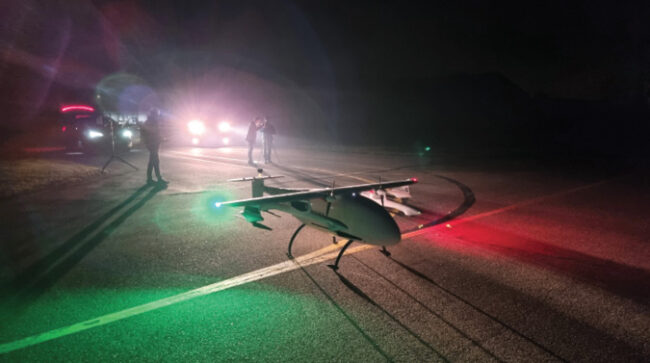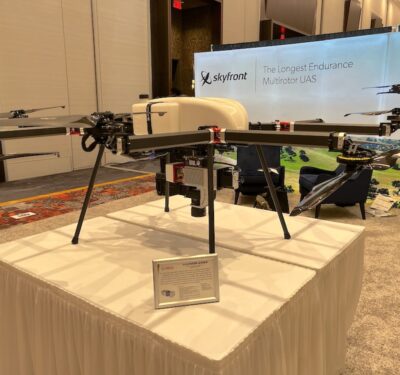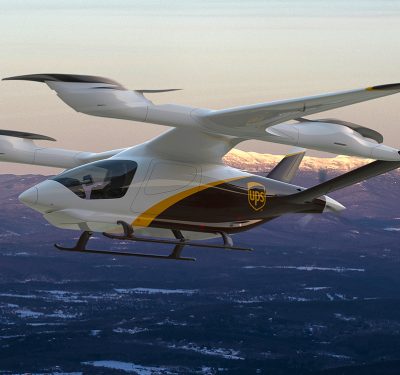
Drone flights beyond visual line of sight are under way in Europe. The process for obtaining a permit to carry out such flights can be confusing and arduous, and the goal of a harmonized framework across all Europe has not been achieved. Improvements, though, could be coming soon.
Israel-based technology developer Percepto was among the first drone operators to receive an official BVLOS permit under new European drone regulations.
“The main challenges were in studying and fully understanding the new European Union Aviation Safety Agency [EASA] drone regulations,” said Shani Brown, Percepto’s director of global policy and government affairs. “We were very proactive in obtaining the BVLOS waiver, submitting the application in November 2021 after months of reviewing the regulations and three months before they came into effect in January 2022.”
Studying and understanding the new EASA drone regulations can indeed be a challenge, according to pretty much everyone Inside Unmanned Systems interviewed.
“In April 2022, only five months after the application was submitted, the Dutch Civil Aviation Authority approved Percepto drones to operate BVLOS,” Brown said. “The approval allows our Dutch partner Falcker to empower its customers to conduct drone flights out of sight of the drone pilot. We believe obtaining this certificate marks a significant milestone in Europe to carry out remote and autonomous inspections, fulfilling Percepto’s mission to provide safe and reliable critical infrastructure.”
Among other things, the approval paves the way for automated inspection and security operations at industrial installations, Brown said.
Duco Boer, Falcker’s chief digital officer, said, “Our typical drone-based applications include asset inspection, security surveillance and emergency response. With the BVLOS permission, we can now go from an infrequent, periodic industrial asset inspection to daily rounds, so this is a significant increase in drone flight frequency, which really opens up a big new range of possibilities.” Current Falcker projects involving BVLOS operations include daily inspection of storage tank terminals at a key industrial site. “We are doing daily checks during product transport and manipulation,” Boer said, “as well as daily floating storage tank roof checks for water accumulation, periodic OGI [optical gas imaging] gas emission checks for floating roof tank seals, and periodic visual and geometrical asset integrity checks for storage tanks, pits, piping and jetties.”
It’s notable that the BVLOS permit in question was not obtained directly from EASA but from the Netherlands’ aviation authority, which used the EASA regulation as a guideline for granting BVLOS permission in its own airspace. More about that later.
VALUING BVLOS
Generally speaking, regulators, operators and industry at large all seem to understand the importance of a clear legal framework that would allow the expansion of BVLOS drone operations.
“European regulators have taken a very hands-on approach to ensure a future where drones play a significant role within industry and everyday life,” Brown said. “We have seen many new regulations and initiatives to standardize drone activities throughout the continent in the last few years, and I think it’s widely accepted that drone technologies, including BVLOS flights, offer significant benefits to critical infrastructure sites and other significant life-saving and societal benefits, such as enhancing worker safety and protecting the environment.”
BVLOS flight enables companies to maximize the power of autonomous monitoring with automated drone inspections performed across large sites with a single pilot in command on the ground, or fully off-site. Conventional inspection methods range from manually climbing infrastructure elements, towers and equipment, to helicopter inspections, all costing a huge amount of time and posing direct risks to employees.
Automated BVLOS drone operations mean faster, safer and more frequent inspection, day in and day out, in almost any weather conditions, all without human intervention. BVLOS operations also make it easier to create data baselines and to monitor trends over time, enabling more consistent reporting and comparison of measurements.
BVLOS flights fulfill an urgent need in the market as heavy industry is increasingly prioritizing consistent and frequent infrastructure inspection, for improved resilience in extreme environments, quicker response to mitigate against disasters, and, in due course, for becoming better corporate citizens.

EUROPEAN REGULATORY EFFORTS
The current European Union Implementing Regulation for UAS Operations, the basis for what is generally refered to as the EASA regulation, specifies the technical, operational and personnel requirements for both VLOS and BVLOS operations. It divides drone flights into three categories: open, specific and certified. BVLOS operations are only possible in the specific or certified category. The certified category is not yet fully applicable, as there are currently no UAS on the market that fulfill the technical requirements for it.
The European Commission press officer for Environment, Maritime Affairs and Fisheries told us, “Drone operators who want to fly BVLOS have several options. They can carry out a ‘specific operation risk assessment,’ a SORA, on which basis the competent authority may grant an operational authorization. They can also qualify for BVLOS permission by submitting an operational declaration of compliance with so-called European ‘standard scenarios.’ And there is also an option to obtain a light UAS operator certificate, LUC, which allows the drone operator to start new BVLOS operation without requiring a prior authorization for each one.”
It’s more complicated than that, but it’s accurate to say the EU and EASA have worked hard to put in place an all-encompassing framework for BVLOS drone flight, and operators are now working very hard to comply with it.
In any case, neither the EU or EASA has the authority to enforce such a framework within individual countries’ national airspace. Only those countries’ national aviation authorities can do that. The role of these national authorities, then, has been to take the EASA scheme and apply it through their own regulation, sometimes adopting the EASA regulation essentially whole and untouched, but more often after a round or more of modification, adaptation and/or further development.
COMPLEX FRAMEWORK
We talked to a number of European national aviation authorities to get a feel for how they sit with BVLOS drone regulations. In general, they described processes very much like the one laid out by the European Commission. In the Netherlands, Royal Netherlands Army Capt. Jeroen Verburg, public affairs officer at the Ground-Based Air Defense Command in the Ministry of Defense, said, “For BVLOS drone systems without a military type certificate, an approval is required from the Netherlands Military Aviation Authority [NLD MAA], so a request needs to be sent to that authority, which is working in close cooperation with the European Defense Agency.
“We are now in the process of implementing the EASA regulation for drone operations, at this moment focusing on the open and specific categories. The certified category will follow at a later stage. The NLD MAA will follow EASA regulations as much as possible, but allowing exemptions for state aircraft where needed.”
According to the Federal Ministry for Digital and Transport (FMDT) in Germany, BVLOS operations in the specific category require an operational authorization from that country’s Civil Aviation Authority. The FMDT supports the risk-based approach laid out in the EU/EASA regulation. Thus, UAS operators must meet a set of technical, personnel and operational requirements based on the already-described operational risk analysis. This approach, it said, works very well and many BVLOS operations have already been approved in Germany, creating new opportunities for UAS operators there.
FMDT is working in consultation with the European Commission to continuously improve UAS-related regulations in Europe, it said. The FMDT also has a very good working relationship with EASA and is actively engaged with them to further develop the framework for UAS operations in Europe.
Meanwhile, in Belgium, a spokesperson for the Federal Public Service for Mobility and Transport said, “Belgium applies the standard EU regulation for BVLOS flights under the specific category. To obtain a BVLOS flight authorization, applicants need to perform a risk assessment, also known as a SORA.”
Once the online application is considered acceptable, a flight authorization is issued to the operator. The submitted file and the evidence must be in accordance with article 11 of the [EASA] Easy Access Rules. Belgium, said the spokesperson, is working in cooperation with EASA to best meet the needs of operators and to be in line with EASA’s vision, and this within the limits of the EU regulation. The regulation will continue to evolve based on experience gained and feedback received from, amongst others, the EU member states and EASA. Once a new regulation is published, Belgium will apply it.
On the face of it, this all looks pretty straightforward, pretty standard. Falcker’s Boer spelled out the problem: “We see that the EU drone rules are supposed to be harmonized, but the actual application processes look really different per country and sometimes even per region, like in Germany. It was a very complex framework to start with, and we see many new additions still going on. There are a lot of differences of interpretation per EU member state. A good example is the procedures and rules used inside controlled airspace. I am a board member of the Dutch association of professional drone operators and we see that most drone operators are struggling to keep up with their compliance. It has become very difficult for newcomers to enter the market and drone operators see little chance of cross-border operations, because of the different application processes and interpretation per EU member state.”

Oliver Heinrich.
“EASA started out with the aim of unifying everything, having a uniform approach across Europe,” said Oliver Heinrich of BHO Legal, an expert in international aerospace law. “What you want to do is cover the common [EU] market, which was the whole point of the new EASA basic regulation, and we saw it was going in that direction. But when it came to implementation, they left so many open points for the member states to interpret. Now we’re in a situation where it’s basically a mosaic of regulations. And it’s getting even more complex with U-Space coming.”
As defined by the EU’s SESAR Joint Undertaking, U-space is a set of new services relying on a high level of digitization and automation of functions and specific procedures designed to support safe, efficient and secure access to airspace for large numbers of drones.
“We have no U-Space,” said Heinrich, who serves on the national drone council of the German Ministry of Transport. “This is another one of the big issues. We see already that Austria appears to be shying away from U-Space. They say it’s too complicated, it’s an additional layer on top of everything else.”
CHANGES IN ATTITUDES?
Phoenix-Wings is a German manufacturer of cargo drones, now licensed for BVLOS operations in its home country and in other European countries. Phoenix-Wings Lead Systems Engineer Sven Wlach sees the BVLOS regulation as a work in progress.


“The EASA idea was about the whole European thing, and it is very much recognized that this is not yet the case. We can look at the problems we are seeing in different countries. Holland, for example, is special. It is very difficult to get permission in Holland. It’s not the same as getting permission in Germany, but we have been through the Dutch process and it is doable. There’s actually a Dutch company called AirHub that helps drone companies get approvals. They are very big there and we are also in touch with them,” he said.
“In general, I would say national interests need to be put aside, and people are beginning to understand this, especially in Germany where, on top of everything, we have this federalism of multiple states. For now, it is still very difficult for companies to work across borders, but I think we are seeing changes in attitudes.
“Work needs to be done by EASA, the national authorities and industry. In some areas we as operators are still guessing what we should do, and we go in and say this is what we think and maybe the authorities say OK, that sounds good enough, or maybe not, and that sucks, honestly, right?”
Small companies are the most disfavored by the current situation. We spoke to a Belgian company that abandoned its BVLOS ambitions altogether after hitting the regulatory wall in their country.
“Yes, that is happening, with a small company that might not have the resources to chase all this stuff down,” Wlach said. “But then, that is a typical thing in aviation. You need a long run. The old saying about how to make a small fortune in aerospace is still valid—you start with a big one.”
Phoenix-Wings cut its BVLOS teeth some years ago in Africa, carrying out successful cargo delivery missions, including medical transport services to an island 20 kilometers into Lake Kivu in Rwanda.
“Our African experience has been quite interesting,” Wlach said. “If you think globally, you have two big regulatory systems, the FAA and EASA. African countries are very much following the EASA approach, and mostly down to the detail, without all the modifications and adaptations we see here in Europe.”
So, the EASA BVLOS regulation process has not been perfect. Still, there are success stories to be told. Percepto is one. Phoenix-Wings is another.
“While each regional authority has its own set of rules, all waiver processes have a strong focus on ensuring safe drone operations,” Percepto’s Brown said. And this, after all, is the prime directive, making the odd hiccup ultimately excusable.
For the European Commission, the establishment of safe and efficient BVLOS drone operations can lead to a whole new, innovative air mobility market, encompassing international, regional and urban air mobility services, to emerge with new types of vehicles. This would represent a major development for the transportation of both freight and people, reducing congestion and increasing efficiency across all transport modes. And that is certainly a goal worth driving, or flying, toward.






